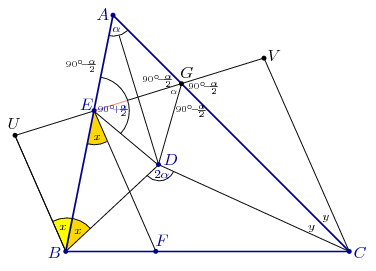 Problem A. 495. (December 2009)
Problem A. 495. (December 2009)
A. 495. In the acute triangle ABC we have  BAC=
BAC= . The point D lies in the interior of the triangle, on the bisector of
. The point D lies in the interior of the triangle, on the bisector of  BAC, and points E and F lie on the sides AB and BC, respectively, such that
BAC, and points E and F lie on the sides AB and BC, respectively, such that  BDC=2
BDC=2 ,
,  AED=90o+
AED=90o+, and
 BEF=
BEF= EBD. Determine the ratio BF:FC.
EBD. Determine the ratio BF:FC.
(5 pont)
Deadline expired on January 11, 2010.
Solution. Let G be the reflection of E through the bisector AD. Reflect point D through the lines AB and AC; denote the reflections by U and V, respectively. We have UE=DE=DG=VG.
From the deltoid AEDG we obtain and
.
Moreover, and
.
Since BEU =AEG
=AEG and CGV
and CGV =AGE
=AGE , the ponts U, E, G and V are collinear.
, the ponts U, E, G and V are collinear.

Leet BEF =BDE
=BDE =EBU
=EBU =x and CGF
=x and CGF =CDG
=CDG =GCV
=GCV =z. From the quadrilateral ABDC and the triangle ABC, we have x+y=360o-
=z. From the quadrilateral ABDC and the triangle ABC, we have x+y=360o- -(360o-2
-(360o-2 )=
)= and
and
UBC +BCV
+BCV =(ABC
=(ABC +x)+(ACB
+x)+(ACB +y)=180o.
+y)=180o.
Therefore, the lines BU and CV are parallel. Due to EBU =VEF
=VEF , also the line EF is parallel with them.
, also the line EF is parallel with them.
Hence,
Statistics:
5 students sent a solution. 5 points: Bodor Bertalan, Éles András, Nagy 235 János, Nagy 648 Donát. 2 points: 1 student.
Problems in Mathematics of KöMaL, December 2009
